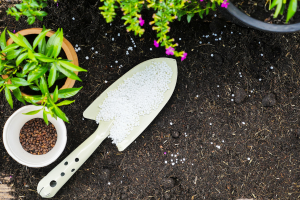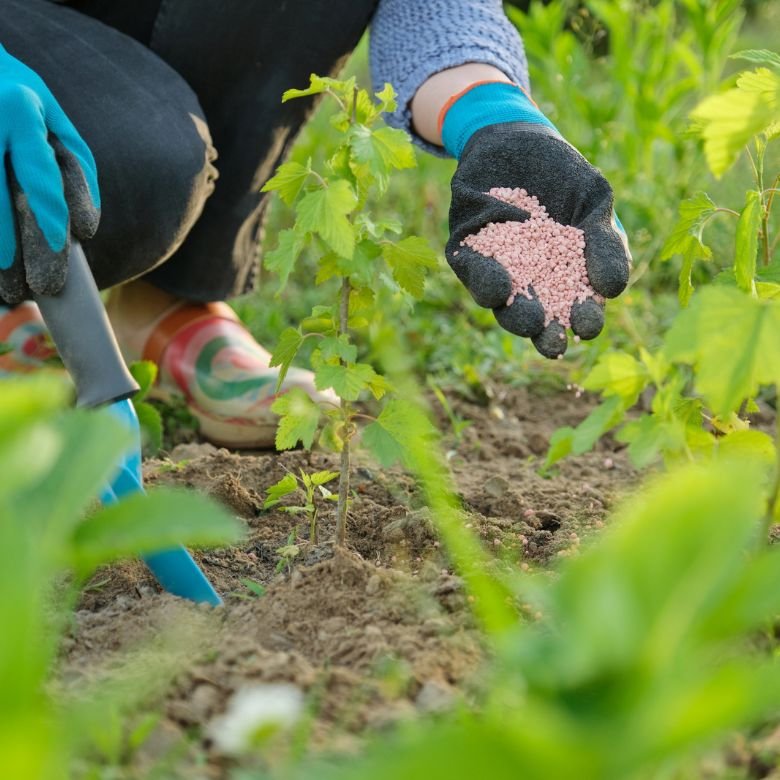Chemistry can be seen almost everywhere in gardens. Plants need many various minerals for healthy growth and reproduction. For example, plants conduct the process of photosynthesis, which is a series of chemical reactions. Each of the elements and chemical compounds present in soil has specific functions, such as to co-create organic structures, catalyse enzymatic reactions, to act as a charged carrier to maintain electrochemical balance, or to regulate osmotic pressure. Trying to understand these and other phenomena, you can quickly see that the garden is a unique place.

Composition and chemical properties of the soil
Soil is the outer surface layer of the Earth’s shell. To a large extent, its composition depends on the type of bedrock undergoing soil-forming processes. A number of elements and chemical compounds can be found in the soil. Almost half of the soil composition is mineral substances. They are divided into macroelements, i.e., potassium, sodium, calcium, aluminium, silicon, carbon, iron, phosphorus, nitrogen and hydrogen, and microelements, i.e., boron, manganese, molybdenum and zinc. Typically, microelements are present in the soil as minerals. Soil also includes gases, especially those present in air. These include carbon dioxide, methane, hydrogen sulphide and ammonia. Among all the elements in the soil composition, oxygen has the largest mass share, followed by silicon and aluminium.
One of the characteristic chemical properties of soil is its pH. In practice, it is we speak of it by referring to the pH scale. Most plants prefer a neutral pH between 6.5 and 7.5, but some plants will grow favourably in a wider range (5.5 to 8). When the soil becomes too acidic or too alkaline, some of the chemical components will become unavailable to plants. That is why pH is so important. The reaction of soil has a direct impact on its fertility, and therefore productivity. Calcium ions have a great influence on the pH of soil. They come mainly from calcium carbonate. Together with carbonic acid, they form a buffering system that prevents rapid pH changes, which is extremely important for plants since roots are sensitive to rapid pH changes. This ability of soil to maintain a constant pH value (despite the presence of factors changing its value) is called buffering properties. This occurs when the soil contains mixtures of buffer systems, e.g., a weak acid and its salt. They may cause the lack of pH changes despite the use of appropriate de-acidifying or acidifying fertilisers.
The redox potential is another important chemical property of soil. This parameter is closely related to humidity. The more humid the soil, the less oxygen content. Soils containing large amounts of O2 are considered as having good aerobic conditions. This is important for plant growth, because in such soil, the processes of oxidation of mineral and organic compounds can occur uninterrupted. When the measured redox potential is too low, it may be a sign of excess of moisture in the soil. Then, first of all, reduction phenomena are observed, e.g., of nitrates, which leads to the loss of valuable nitrogen from the soil.
Chemical processes in the garden
Plants and soil are the pillars of any garden. Being their natural element, they are the locations of most important chemical processes.
- The best-known process in the case of plants is photosynthesis. It enables the production of necessary plant structural compounds and substances required for proper functioning. Photosynthesis is the transformation of carbon dioxide and water into glucose and oxygen. This reaction takes place in the presence of energy from the light of the sun. Photosynthesis is the most important of the processes that sustain life on Earth.
- Composting is a popular method of managing green waste in gardens. This organic recycling consists of the decomposition of organic matter by microorganisms. Its key phase is the mineralisation of organic matter from plant and animal remains, which results in the formation of simple mineral compounds. Mineralisation involves two processes: putrefaction and rotting. The first occurs in anaerobic conditions. Mineral compounds formed via putrefaction include carbon dioxide, water, ammonia, and hydrogen sulphide. On the other hand, rotting takes place in the presence of oxygen. It favours the formation of oxides, phosphate or sulphate ions. Easily degradable compounds, such as sugars, starch or proteins, are particularly susceptible to mineralisation. They are a valuable source of elemental carbon and nitrogen for microorganisms.
- Many of the chemical processes observed in gardens involve the circulation of elements. A particular example is nitrogen, which as a gas makes up about 78% of the air, and in soils it is a key nutrient for most plants. Living organisms draw atmospheric nitrogen via bacteria. They have the ability to uptake molecular nitrogen and transform it to ammonia. This form can then be taken upby plants and used to produce organic molecules. When the plant is eaten by an animal, this element enters its body. The nitrogen contained in the plant and remains in the animal, which then dies, and as a result of subsequent chemical reactions is transformed into ammonia and molecular nitrogen, which then re-enters the atmosphere.

Fertilisers and plant protection products
The climate and chemical processes taking place in the garden mean that over time it will become poorer in nutrients. This process is called soil depletion. In natural gardens, nutrients return to the soil with the death and decay of the plant, but the process is disturbed in soils where crops are grown and then are harvested. The less well-nourished the soil, the harder it is for plants to survive. Fertilisers are used to supplement the deficiencies of elements in soil. Importantly, the fertilisation method and the selection of appropriate fertiliser is not easy and depends entirely on the condition of soil and plant nutritional needs.
Today, two types of agricultural fertilisers are used:
- Natural (organic) – these are, first of all, fertilisers of plant and animal origin. The most commonly used one is compost. It is made from the remains of plants and such things as mowed grass or leaves. It is formed as a result of their aerobic bacterial decomposition. Compost is rich mainly in nitrogen, but also in phosphorus (V) oxide and potassium oxide. The quality of the fertiliser is assessed based on the content of the above-mentioned elements. Other natural fertilisers are manure derived from the excreta of farm animals and biohumus derived from the excreta (‘castings’) of California earthworms. It should be noted that natural fertilisers will not always contain all the necessary chemical elements.
- Artificial (mineral) – these fertilisers have high efficiency and faster action compared to natural fertilizers. Artificial fertilizers contain primary components such as nitrogen, phosphorus and potassium, secondary components such as calcium, magnesium, sodium and sulphur as well as micronutrients including boron, cobalt, copper and iron. Artificial fertilisers are categorised as simple (with the declared amount of the main ingredient – nitrogen, phosphorus or potassium fertilizer) and compound (containing at least two nutrients, obtained during a chemical reaction). The most commonly used artificial fertilisers include: triple superphosphate, callimagnesia, ammonium sulphate, magnesium sulphate and polyphosphate.
See the range of agrochemicals from the PCC Group.
Without doubt, chemical plant protection products are a good example of the presence of chemistry in gardens. Their main goal is the active protection against pests, such as insects, snails and slugs, weeds and fungi. They are active substances or preparations containing one or several active ingredients. Chemical plant protection products are categorised mainly as fungicides, herbicides, insecticides, adjuvants and growth regulators. They contain various chemical substances, including phosphorus oxychloride, phosphorus trichloride, monochloroacetic acid and paradichlorobenzene. Caution is especially important when working with these substances.